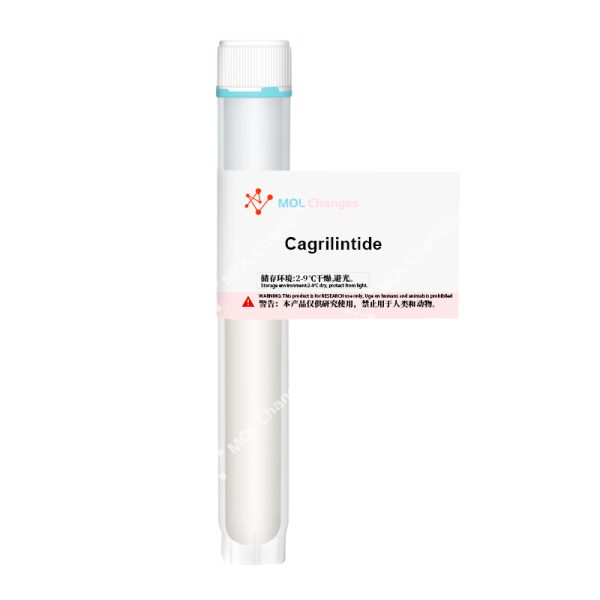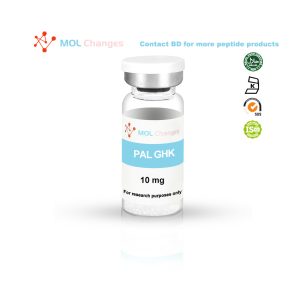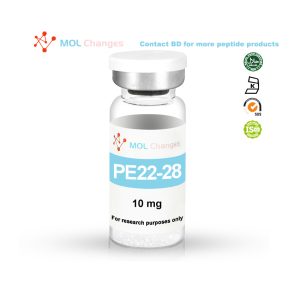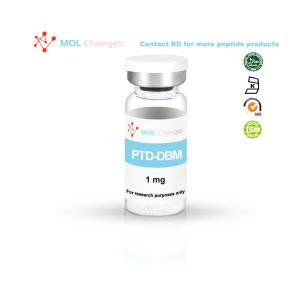Carglintide is a long-acting analog of glucagon, a naturally occurring peptide released with insulin. Animal studies have demonstrated the promise of carglintide for the treatment of obesity and type 2 diabetes. Studies have shown that it is not only beneficial for type 2 diabetes, but also for liver damage, alcoholic liver disease, and cardiovascular disease. There has also been some speculation about the role of this peptide in Alzheimer’s disease, but no relevant research has been published in this area. However, many trials have examined the combination of carglintide and somatostatin for the treatment of obesity and type 2 diabetes. The two proteins appear to work synergistically to provide stronger, longer-lasting weight loss.
Sequence
XKCNTATCATQRLAEFLRHSSNNFGPILPPTNVGSNTP
CAS Number
1415456-99-3
Molecular Formula
C194H312N54O59S2.xC2H4O2
Molecular Weight
4409.01 g/mol
Cagrilintide Related research
Glucagon (also known as islet amyloid polypeptide or IAPP) is a naturally occurring peptide that is released from pancreatic beta cells along with insulin. Research has shown that it is an important signaling molecule in the brain that produces the feeling of satiety. Glucagon is released as a prepeptide that is 89 amino acids in length and has an approximate 100:1 ratio to insulin.Like insulin, glucagon is processed to produce a smaller active molecule that is only 37 amino acids in length.
Tryptophan has a variety of effects, including slowing gastric emptying, promoting a feeling of fullness in the brain, and preventing spikes in blood sugar levels after eating. Pancreatic amylin works primarily by slowing the rise in blood sugar levels after eating. This helps to control the utilization of sugar so that it is more likely to be converted into an energy source rather than into fat.
Pancreatin has also been shown to act on bone metabolism and is structurally and functionally related to both calcitonin and calcitonin gene-related peptide (CGRP). All of these peptides help to lower blood calcium levels by stimulating calcium absorption in the bones. It may also affect the rate of calcium loss from the kidneys, but the extent to which this is significant is currently unknown [2]. In short, tryptophan can be thought of as increasing the rate of bone deposition or protecting bone from degradation.
In animal studies, the tryptophan gene was silenced, resulting in decreased appetite and lower calorie intake. The degradation enzymes for glucagon are the same as those for insulin [3]. However, carglintide has been engineered to be resistant to these enzymes, giving it a longer half-life and thus a more potent and long-lasting effect.
While still theoretical, it is worth pointing out that glucagon has been linked to the beta amyloid plaques observed in Alzheimer’s disease. In short, excess glucagon has been linked to insulin resistance and diabetes. Due to the self-dimerizing properties of tryptophan, excess tryptophan leads to the formation of fibrillogenic fibrils. It is thought that the interaction of these fibrillar fibrils with beta amyloid in the brain may be responsible for the formation of amyloid plaques, but the causal relationship between the two is unclear.
What is Karglin peptide?
Karglin peptide is a synthetic analog of the natural protein tryptophan. It resists degradation by proteases in the blood and therefore has a longer half-life. Carglintide is not the first glucagon analog to be developed. That distinction belongs to the development of pramlintide in the early 21st century. Pramlintide was initially used as an adjunct to insulin therapy to reduce insulin dosage for blood sugar control. Essentially, it improves glycemic control by reducing the magnitude of post-meal blood sugar spikes in many diabetics. The main difference between carglintide and pramlintide is its significantly longer half-life.
Extending the half-life of glucagon is not the only benefit of carglintide. This synthetic peptide also prevents protein aggregation, a common problem with pancreatic amylin. Aggregation occurs when tryptophan is present in extremely high concentrations in the bloodstream, causing the protein to lose its function. Amyloidogenic fibers have been linked to toxic effects on pancreatic beta cells and are thought to contribute to type 2 diabetes. The current hypothesis is that overeating leads to increased release of insulin and glucagon. This, in turn, leads to high levels of pancreatic amylin, which triggers aggregation. Toxic pancreatic amylin tangles, not too dissimilar to the beta amyloid tangles observed in Alzheimer’s disease, lead to the death of pancreatic beta cells, which results in the inability of the pancreas to produce enough insulin [4].
Carglitazone is a marvel of modern design, developed in a way that minimizes the side effects of natural pancreatic amylin. Pancreatic amylin is well suited to function when released by the pancreas, but is highly unsuitable for exogenous administration. To overcome trypticin’s tendency to form protofibrils, scientists added a proline residue to the C-terminus of trypticin. Adding an amide residue to the same end improves receptor binding. Then, to improve the permeability of the peptide to the brain, fatty acid residues were added to the N-terminus [5]. Together, these changes to natural tryptophan allow for better binding to RAMP-1 and RAMP-3 receptors.
RAMP receptors (receptor activity modifying proteins) are a family of proteins that interact with and modify the function of G-protein coupled receptors.RAMP-1 and RAMP-3 interact with calcitonin-like receptors, calcitonin receptors, and calcium-sensitive receptors.RAMP-3 interacts with tryptophan receptors. The exact functional consequences of many of these interactions are unknown, but RAMP receptor dysfunction has been linked to a variety of diseases, including cardiovascular disease, diabetes, and cancer [6].
How does Karglin peptide work?
There are multiple mechanisms of action for carglintide. In the gastrointestinal tract, carglin peptide slows down the transportation of food. This stimulates the gastrointestinal tract to send satiety signals to the brain. This moderates the hunger response, which reduces food intake. Slowing the transportation of food through the GI tract also reduces the rate of sugar absorption. This helps to smooth out blood sugar spikes and gives the body time to process the sugar load, thus avoiding the conversion of excess sugar into fat.
Karglin peptide also acts directly on the central nervous system. Mouse studies have shown that there are many glucagon receptors in the arcuate nucleus of the brain. Binding in this region directly affects the brainstem and pituitary gland, which contributes to feelings of satiety and reduces the desire to eat.
Finally, kagrin peptides act in the pancreas, just like glucagon, to help reduce the release of glucagon through a feedback loop. This reduces the conversion of glucose to fat [7].
Carglintide: obesity study
Two important trials have been conducted with carglintide and are worth reviewing to understand the overall efficacy of the peptide. A weekly dose of carglintide resulted in a 6-11% reduction in total body weight in just six weeks compared to placebo. This rate of loss was higher than that of liraglutide, which was used as a positive control in that trial. Overall, the incidence of side effects was approximately the same for carglintide and liraglutide [8].
In the second trial, the combination of carglintide and somatostatin produced more significant weight loss than either peptide alone. In fact, the effect would have been more significant than expected if it were simply a stacking effect. As a result, researchers concluded that carglintide and somatostatin had a synergistic effect, with weight loss of up to 17.1% in 20 weeks [9]. For someone weighing 200 pounds (about 91 kg), a 17% weight loss is equivalent to a 34-pound weight loss …… and this occurs in just 5 months!
Carglin peptides in diabetes
Carglin peptides and similar drugs (e.g., pramlintide) can significantly reduce insulin resistance and glycated hemoglobin (A1C) levels by inhibiting glucagon secretion. In fact, studies of these peptide therapies have shown a 2.2% decrease in A1C levels over a short period of time [10], [11].
Carglintide has been shown to only need to be taken once a week. This improvement has not only made carglintide more palatable to administer, but has also increased its efficacy. Its longer half-life means better glycemic control over the long term and, in the case of weight loss, longer-lasting appetite suppression.
Carglintide in Alzheimer’s Disease
The link between blood sugar control and cognitive dysfunction has long been known. For example, even in young adults, diabetes can lead to impaired memory, attention, and processing speed. Hyperglycemia (high blood sugar) may activate protein kinase C, which directly damages brain cells. It may also increase overall levels of inflammation and oxidative stress, leading to overall cognitive decline as well as other diabetes-related conditions such as heart disease and kidney disease.
Studies have repeatedly demonstrated the relationship between blood sugar and cognitive function. Both hyperglycemia and hypoglycemia can cause problems for the brain, but the focus of this article is on hyperglycemia. For example, a four-year study of older women showed that chronically elevated blood sugar was associated with an increased risk of mild cognitive impairment and dementia [12], [13]. Interestingly, the study suggests that high blood sugar may lead to lower glucose levels in the brain. This is problematic because the brain relies almost entirely on glucose for energy. This is consistent with the results of another study that showed that brain insulin resistance is a key pathogenic mechanism for cognitive dysfunction in diabetes [14], [15]. Overall, these studies suggest that the inability of the brain to utilize glucose, even (or perhaps especially) when blood glucose levels are too high, is a key factor in dementia.
Research likewise suggests that glucagon levels may also be associated with cognitive dysfunction. As with blood glucose, high or low levels of insulin in the blood can be detrimental to brain function. Data from the Framingham Heart Study suggests that cognitive function is U-shapedly correlated with insulin levels, with both low and high insulin levels associated with an increased incidence of cognitive dysfunction and an increased risk of Alzheimer’s disease [16].
The link between blood glucose levels, diabetes and Alzheimer’s disease is not new. In fact, in the past Alzheimer’s disease was sometimes referred to as type 3 diabetes. This nomenclature has recently come back into vogue with the re-examination of the link between blood glucose and cognitive dysfunction. The link between insulin and cognitive function has also received renewed attention.
Glucagon readily crosses the blood-brain barrier and shares several characteristics with beta amyloid, the major component of amyloid plaques closely associated with Alzheimer’s disease. beta amyloid and glucagon both have similar beta-folded secondary structures, bind to the same receptors in the brain, and are degraded by the same proteases. Although a direct link between tryptophan and beta amyloid has not been established, it is highly suspected that they are connected. For example, research in 2014 showed a strong correlation between blood levels of tryptophan and levels of amyloid plaque precursors in the brain. This correlation was so strong that it remained even after controlling for age, gender, race, BMI, diabetes severity, stroke, kidney function, lipid levels, and the presence of the ApoE4 DNA marker associated with Alzheimer’s disease. More strikingly, it was found that injecting synthetic insulin into a mouse model of Alzheimer’s disease cleared amyloid plaques from the brain and increased blood levels of amyloid plaques [17]. Interestingly, this may be because excess tryptophan causes cross-linking to occur in the blood. This prevents tryptophan from crossing the blood-brain barrier, which may lead to beta amyloid accumulation and amyloid plaque formation.
All of this seems to indicate a strong link between tryptophan and the development of cognitive dysfunction. Although a great deal of research is still needed, carglintide and similar peptides hold promise for the treatment or prevention of Alzheimer’s disease. This area of research is currently being actively explored and is open to ambitious researchers. However, there are no published studies on the role of carglintide in removing beta amyloid from the brain or preventing/treating cognitive dysfunction.
COA
HPLC
MS
- “Chronically high blood sugar linked to risk of cognitive impairment | UC San Francisco.” Accessed: Oct. 28, 2024. [Online]. Available: https://www.ucsf.edu/news/2006/08/97884/chronically-high-blood-sugar-linked-risk-cognitive-impairment
- Y. Yang, J.-J. Zhao, and X.-F. Yu, “Expert Consensus on Cognitive Dysfunction in Diabetes,” Curr Med Sci, vol. 42, no. 2, pp. 286–303, Apr. 2022, doi: 10.1007/s11596-022-2549-9.
- W. Q. Qiu, M. Wallack, M. Dean, E. Liebson, M. Mwamburi, and H. Zhu, “Association between amylin and amyloid-β peptides in plasma in the context of apolipoprotein E4 allele,” PLoS One, vol. 9, no. 2, p. e88063, 2014, doi: 10.1371/journal.pone.0088063.
Article/Literature Citation Notes
The purpose of quoting the scientist and professor's article is to acknowledge, recognise and applaud the exhaustive development work that has been done to undertake this peptide research. The scientist does not in any way support or advocate the purchase, sale or use of this product for any reason, and MOL Changes has no affiliation or relationship, implied or otherwise, with the scientist.
warning
These products are intended for scientific purposes only for in vitro research and are not to be used for human, animal or unethical experiments, in vitro research (Latin: in glass) is conducted in vitro. These products are not drugs and are not approved by the Food and Drug Administration in any country for the prevention, treatment or cure of any medical condition, disease or illness. The introduction of this product into humans or animals in any form is strictly prohibited by law.







Reviews
There are no reviews yet.